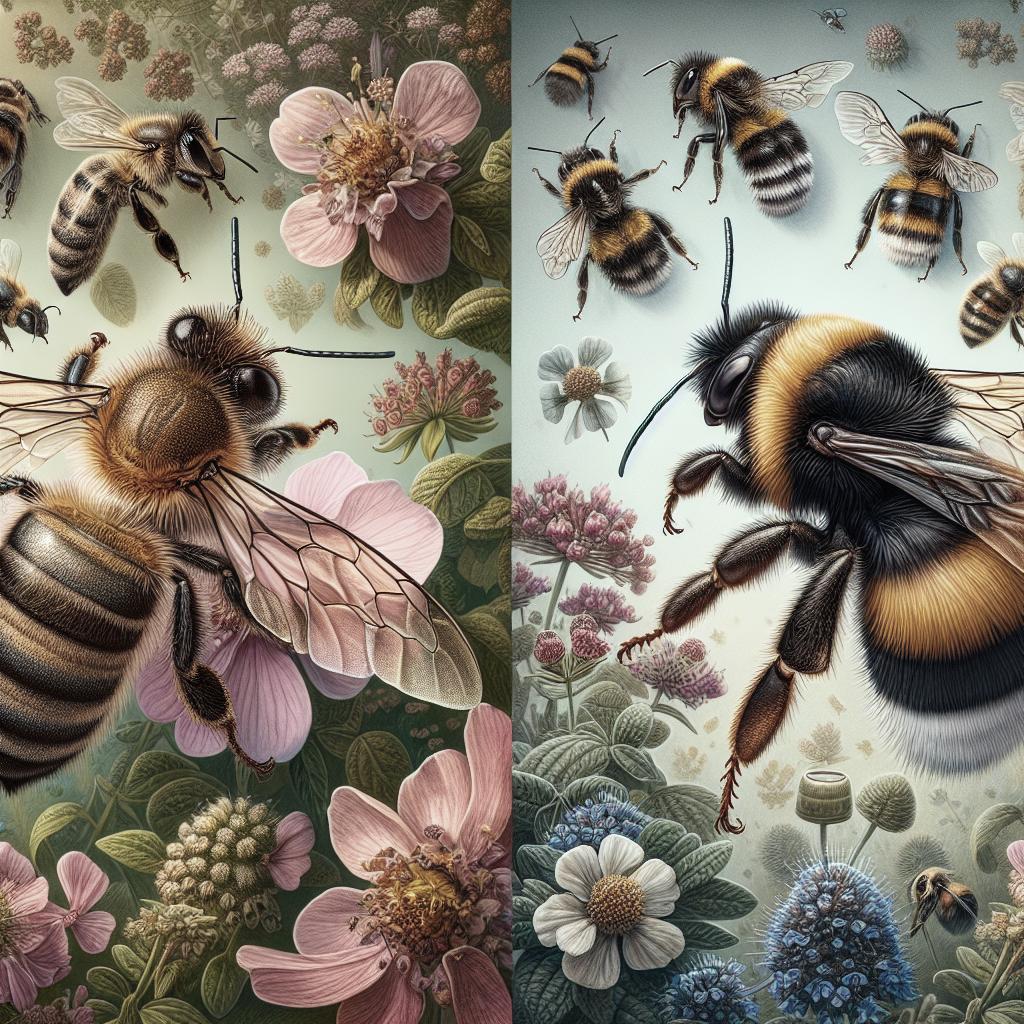Exploring the Differences Between Honeybees and Bumblebees
Bees play a crucial role in maintaining ecosystems due to their exceptional pollinating prowess. Among the diverse species, honeybees and bumblebees are particularly significant, yet they possess distinct characteristics and behaviors. This blog post aims to delve into the differences between these two vital pollinators. We will explore their presence in Alabama, the distinct ways they contribute to pollination, their unique living conditions, and their stinging capabilities. Moreover, we will discuss the methods to manage bee populations effectively. By understanding these aspects, we can better appreciate the roles both honeybees and bumblebees play, ensuring their protection and promoting biodiversity.
Bees That Are Found in Alabama
Alabama, with its diverse floral landscape and favorable climate, serves as a habitat for various bee species, including both honeybees and bumblebees. The state is home to nine types of bumblebees, alongside the European honeybee, which was introduced to North America in the 17th century. While these bees are prevalent in many regions, their populations and distribution in Alabama depend on factors such as climate, availability of flowers, and anthropogenic influences.
Honeybees, known for their structured colonies and honey production, are often found in managed hives by beekeepers, enhancing their visibility and interaction with humans. On the other hand, bumblebees are more likely to be spotted in wild habitats, such as gardens, meadows, and forests. Their larger and fuzzier appearance makes them prominent in the landscape during the warmer months. Both bees contribute immensely to Alabama’s agriculture and natural beauty, pollinating crops and wildflowers.
Pollination Activities of Honeybees and Bumblebees
Pollination is a critical ecological service performed by both honeybees and bumblebees, albeit in different manners. Honeybees are renowned for their rigorous and systematic approach to pollination, making them a favorite among agricultural sectors. They are efficient pollinators that move methodically from flower to flower, ensuring pollination of a wide range of crops. The structure of their legs allows them to collect pollen effectively, which is used as food and stored in their hives.
Bumblebees, however, are nature’s select pollinators for specific plants. They exhibit a behavior known as “buzz pollination,” where they vibrate their bodies to release pollen from flowers that pollen might otherwise be inaccessible. This makes them particularly adept at pollinating plants such as tomatoes and berries. Their ability to forage in cooler temperatures and low-light conditions gives them a crucial advantage over honeybees in certain environments.
Living Quarters of Different Bees
The living quarters of honeybees and bumblebees differ significantly. Honeybees live in large, structured colonies that can contain tens of thousands of individuals. These colonies are found within man-made hives or natural cavities and consist of a queen, worker bees, and drones. The architecture of a honeybee hive is known for its complex arrangement, optimized for production and storage of honey, as well as rearing of young bees.
Bumblebees, in contrast, have smaller colonies averaging a few hundred individuals. Their nests are typically found underground, often in abandoned rodent burrows or in dense grass. Bumblebee nests are less organized than honeybee hives and are more vulnerable to environmental threats. These bees do not produce honey in significant quantities, as their colonies are annual, with only the queen surviving over winter to establish a new colony the following year.
Stinging Capabilities
The stinging capabilities of honeybees and bumblebees are another point of divergence. Honeybees possess a barbed stinger, which can only be used once, as it remains lodged in the victim’s skin. After stinging, the bee experiences a fatal injury, losing part of its abdomen and dying shortly thereafter. Due to this, honeybees only sting in defense of their hive or when they feel threatened.
Bumblebees, on the other hand, have a smoother stinger that allows them to sting multiple times without harm. While bumblebees are generally non-aggressive and prefer to avoid confrontation, they will defend themselves and their nests if provoked. Understanding these differences is crucial for safely managing bee interactions in natural and urban environments.
Controlling Bees and Their Nests
Controlling bee populations, especially when they nest in unwanted areas, requires a delicate balance between ensuring human safety and preserving these critical pollinators. For honeybees, beekeepers can often relocate hives if the bees pose a threat, ensuring the colony survives and continues to contribute to biodiversity. Proper hive management and placement reduce the risks associated with honeybee populations in residential neighborhoods.
Bumblebee nests, due to their transient nature and smaller colonies, are less likely to require intervention. If a bumblebee nest becomes problematic, it is often sufficient to cordon off the area and wait for the natural die-off as the colony doesn’t survive the winter. Expert pest control services should always be consulted when removal or intervention is necessary, ensuring minimal harm to bee populations while prioritizing human safety.
Future Prospects
The understanding of the differences between honeybees and bumblebees highlights the significance of their roles in pollination and ecosystem health. As we move towards a future with climate variability and increased agricultural demands, protecting these creatures becomes paramount. The following table offers a summary comparison of their characteristics and roles:
| Feature | Honeybees | Bumblebees |
|---|---|---|
| Habitat in Alabama | Managed hives, widespread | Wild areas, gardens, meadows |
| Pollination Technique | Systematic, wide range of crops | Buzz pollination, specific plants |
| Living Quarters | Large hives, thousands of bees | Small nests, underground |
| Stinging Ability | Single sting, barbed stinger | Multiple stings, smooth stinger |
| Population Control | Relocation by beekeepers | Natural die-off, expert intervention if needed |


